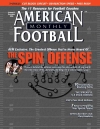AMERICAN FOOTBALL MONTHLY THE #1 RESOURCE FOR FOOTBALL COACHES
Article CategoriesAFM Magazine
|
Establishing a Multiple Attack Running Gameby: Alvin ParkerElizabeth City State University © More from this issue During my time as a coach, I have learned that it is extremely hard to be one-dimensional and have constant success. Some teams do it and have success but on an overall basis we as a staff feel better about our chances with a multiple attack running game. First of all, we think it is much harder for our opponents to prepare for and if a team has success stopping one phase of our running game then we easily can retract to another phase. In today’s business of coaching there is so much turnover in staff, it would be just a waste to have some one on your staff who has knowledge of an offensive running scheme and not use it. The three running plays that will be discussed are our Power, Fly Sweep, and Dart. I know some offensive minds out there are probably saying these a....The full article can only be seen by subscribers. Subscribe today!
|
|
|||||||
| HOME |
MAGAZINE |
SUBSCRIBE | ONLINE COLUMNISTS | COACHING VIDEOS |
Copyright 2025, AmericanFootballMonthly.com
All Rights Reserved





